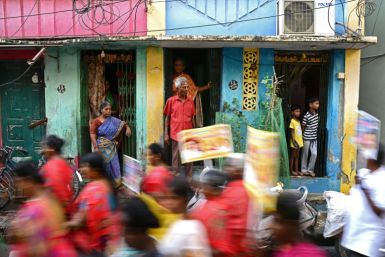Mount Everest Brawl Exposes Clash In Mountaineering World

Three experienced European climbers, who are used to fighting strong winds and frigid temperatures, say they met yet another foe on their latest attempt to conquer Mount Everest: the Sherpa guides.
Nepalese police, the Ministry of Tourism and head of the Sherpa Association are now investigating claims that Sherpas -- local climbers from the Everest region who accompany most foreigners to fix ropes and carry supplies -- attacked the three men after a scuffle at nearly 23,000 feet (7,000 meters).
Italian climber Simone Moro, who has climbed the world’s highest peak four times, issued a statement on his website claiming that as many as 100 Sherpas attacked him and fellow climbers Ueli Steck and Jonathan Griffith after the men knocked ice onto a Sherpa located below them.
“By the time the climbers descended back to Camp 2, some 100 Sherpas had grouped together and attacked,” the statement said. “They became instantly aggressive and not only punched and kicked the climbers, but threw many rocks as well. A small group of Westerners acted as a buffer between the out of control mob and the climbers, and they owe their lives to these brave and selfless people.
“The climbers packed the bare essentials and made a circuitous route back down to the base of Mount Everest in heavily crevassed terrain with no rope on, feeling that, given the current situation, this was the safest place to be.”
An American witness who spoke via telephone with AFP on the condition of anonymity said the whole ordeal was “terrifying to watch,” but added that the three hikers had ignored the Sherpas’ instructions.
“The Sherpas told the team not to climb above them while they were fixing the ropes but they did it anyway,” the witness said. “Then some ice fell and hit the Sherpas, which made them angry.”
Tourism Ministry official Dipendra Paudel played down the alleged brawl, but told Reuters the government would ensure the Europeans’ safety and security.
“There was a slight misunderstanding and communication gap between [the guides and climbers],” Paudel said. “This has been sorted out and the climbers are at the base camp.”
Paudel added that the Europeans would resume their bid to climb Everest after mediation meetings Monday afternoon, but Moro said in an interview Monday evening that the violence “killed our climbing dream and we are leaving.”
Nepali officials vowed to ensure the safety of climbers in the wake of the incident on Everest, but also expressed interest in creating a “code of conduct for climbers and mountain staff” to prevent future high-altitude brawls.
An editorial in the Nepali Times Monday pointed to an increasing clash of styles in the mountaineering world between traditional commercial expedition climbing and the newer free alpine climbing, where athletes don’t use Sherpas and climb in small groups without oxygen.
Steck, Griffith and Moro are three of the world’s most notable alpinists, and in an interview with Planet Mountain on Monday evening, Moro acknowledged “we don’t represent much business for the Sherpa.”
Roughly 4,000 climbers have reached the top of Mount Everest since New Zealander Edmund Hillary and Sherpa Tenzing Norgay first conquered the peak in 1953, but Moro said “today’s Everest is too much of a business.”
“The relationship between Sherpa and Westerners has changed a lot,” he noted. “I think the Sherpa are aware of how much money goes into all of this and they no longer accept that it’s not all theirs.”
The traditional spring climbing season runs from mid-March to May and pumps much needed foreign revenue into the impoverished nation, which charges each mountaineer hefty fees to tackle the world’s highest peak. Last season, the government mobilized NPR 270 million ($3.1 million) in revenue from 335 Everest climbers in 30 expedition teams, while this year it expects NPR 254 million from 315 climbers in 29 teams.
Each expedition pays a royalty fee of between $15,000 and $70,000, and the vast majority of the earnings go straight to the government, not the Sherpas.
© Copyright IBTimes 2024. All rights reserved.












